Culturally Targeted Interventions for South Asian Populations: to delay the onset or for improved management of Type 2 Diabetes
Added on 2023-06-11
78 Pages24322 Words108 Views
Running head: DISSERTATION
Culturally Targeted Interventions for South Asian Populations: to delay the onset or for
improved management of Type 2 Diabetes
Name of the Student
Name of the University
Author Note
Culturally Targeted Interventions for South Asian Populations: to delay the onset or for
improved management of Type 2 Diabetes
Name of the Student
Name of the University
Author Note

1DISSERTATION
Abstract
Diabetes mellitus type 2 is a chronic metabolic disorder, the common symptoms of which are
increased blood glucose due to subsequent lack of insulin and insulin resistance among the
affected individuals. T2D commonly occurs due to obesity and a sedentary lifestyle. This
increases the risk of some individuals to suffer from the condition. A combination of genetic
and lifestyle factors are found responsible for the metabolic disorder and some of these
factors are under control of the people. Presence of inappropriate BMI, poor dietary patterns
and absence of physical exercise greatly contribute to the accumulation of body fat among
people of South Asian descent. A high waist to hip ratio is another marker for the presence
of diabetes. South Asian population have been associated with increased consumption of
sweetened drinks, saturated fat, and refined grains such as, white rice that play an important
role in increasing their risks. Insufficient production of the hormone insulin from the
pancreatic cells also contribute to insulin resistance and marks the inappropriate release of
glucose into the bloodstream. Other mechanisms associated with T2D development are lipid
breakdown, increased glucagon and more water and salt retention. This dissertation is an
attempt to conduct a systematic review for investigating the different culturally appropriate
interventions that have been found effective for preventing or managing T2D in the South
Asian population.
Keywords- diabetes, T2D, dietary, South Asian, dietary, exercise, interventions
Abstract
Diabetes mellitus type 2 is a chronic metabolic disorder, the common symptoms of which are
increased blood glucose due to subsequent lack of insulin and insulin resistance among the
affected individuals. T2D commonly occurs due to obesity and a sedentary lifestyle. This
increases the risk of some individuals to suffer from the condition. A combination of genetic
and lifestyle factors are found responsible for the metabolic disorder and some of these
factors are under control of the people. Presence of inappropriate BMI, poor dietary patterns
and absence of physical exercise greatly contribute to the accumulation of body fat among
people of South Asian descent. A high waist to hip ratio is another marker for the presence
of diabetes. South Asian population have been associated with increased consumption of
sweetened drinks, saturated fat, and refined grains such as, white rice that play an important
role in increasing their risks. Insufficient production of the hormone insulin from the
pancreatic cells also contribute to insulin resistance and marks the inappropriate release of
glucose into the bloodstream. Other mechanisms associated with T2D development are lipid
breakdown, increased glucagon and more water and salt retention. This dissertation is an
attempt to conduct a systematic review for investigating the different culturally appropriate
interventions that have been found effective for preventing or managing T2D in the South
Asian population.
Keywords- diabetes, T2D, dietary, South Asian, dietary, exercise, interventions
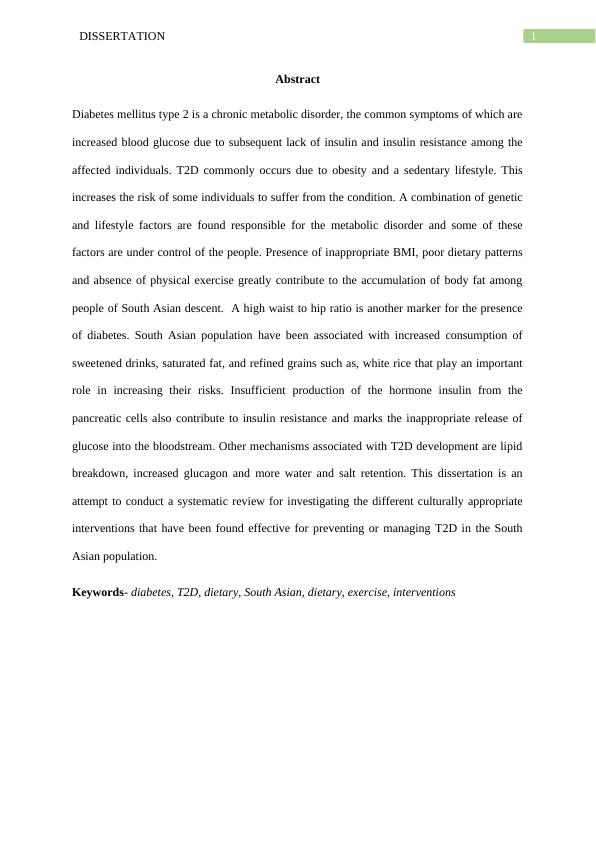
2DISSERTATION
Acknowledgement
I wish to express my deepest gratitude to the dissertation committee chair person
Professor-------, who convincingly and continually conveyed the spirit of research in regards
to this work. Without his continued guidance and help, this research would not have been
successfully accomplished.
I would to acknowledge the help extended by the committee members, Professor ---- and
Professor ----, who helped me engage in an accurate process for searching literature, relevant
to the research topic.
In addition, I would also thank Professor ---, who was imperative in introducing me to the
topic Diabetes, and whose enthusiasm for the same made me consider it an appropriate
subject for the research project. I would also like to thank the University of --- for providing
me the permission to access databases and library resources for the research purpose. I hereby
extend my thanks and gratitude to my family members and friends, without whom this work
would not have been possible.
Acknowledgement
I wish to express my deepest gratitude to the dissertation committee chair person
Professor-------, who convincingly and continually conveyed the spirit of research in regards
to this work. Without his continued guidance and help, this research would not have been
successfully accomplished.
I would to acknowledge the help extended by the committee members, Professor ---- and
Professor ----, who helped me engage in an accurate process for searching literature, relevant
to the research topic.
In addition, I would also thank Professor ---, who was imperative in introducing me to the
topic Diabetes, and whose enthusiasm for the same made me consider it an appropriate
subject for the research project. I would also like to thank the University of --- for providing
me the permission to access databases and library resources for the research purpose. I hereby
extend my thanks and gratitude to my family members and friends, without whom this work
would not have been possible.
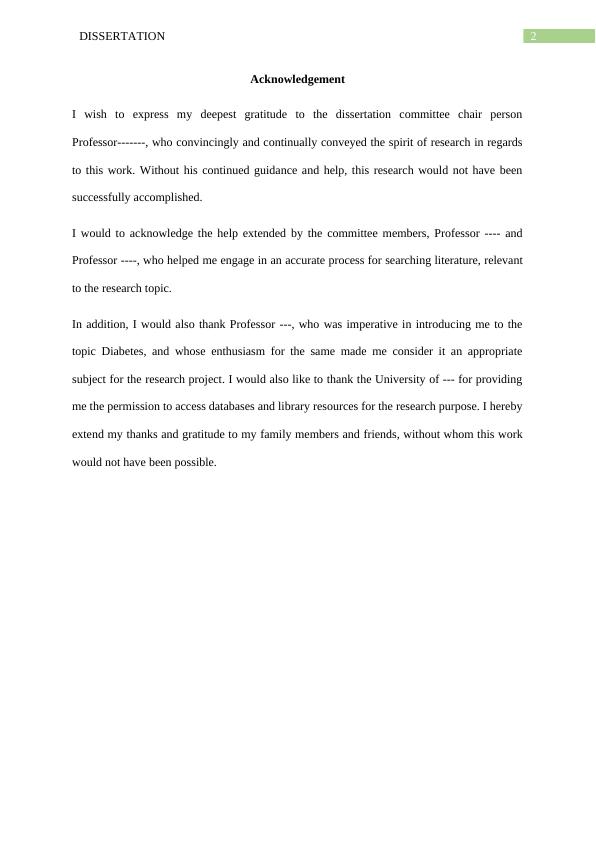
3DISSERTATION
Table of Contents
Chapter 1: Introduction..............................................................................................................5
Background............................................................................................................................6
Rationale................................................................................................................................8
Research aim........................................................................................................................11
Research objectives..............................................................................................................11
Problem statement................................................................................................................11
Chapter 2: Literature review....................................................................................................14
Introduction..........................................................................................................................14
Type 2 diabetes (T2D) prevalence among South Asians.....................................................14
Structured exercise interventions.........................................................................................15
Educational interventions.....................................................................................................16
Culturally Competent Interventions (CCI)...........................................................................18
Multi-component interventions............................................................................................19
Diet modifications................................................................................................................20
Primary T2D prevention in South Asians............................................................................20
Chapter 3: Methodology..........................................................................................................28
Introduction..........................................................................................................................28
Method outline.....................................................................................................................29
Research onion.....................................................................................................................30
The research philosophy......................................................................................................31
Table of Contents
Chapter 1: Introduction..............................................................................................................5
Background............................................................................................................................6
Rationale................................................................................................................................8
Research aim........................................................................................................................11
Research objectives..............................................................................................................11
Problem statement................................................................................................................11
Chapter 2: Literature review....................................................................................................14
Introduction..........................................................................................................................14
Type 2 diabetes (T2D) prevalence among South Asians.....................................................14
Structured exercise interventions.........................................................................................15
Educational interventions.....................................................................................................16
Culturally Competent Interventions (CCI)...........................................................................18
Multi-component interventions............................................................................................19
Diet modifications................................................................................................................20
Primary T2D prevention in South Asians............................................................................20
Chapter 3: Methodology..........................................................................................................28
Introduction..........................................................................................................................28
Method outline.....................................................................................................................29
Research onion.....................................................................................................................30
The research philosophy......................................................................................................31
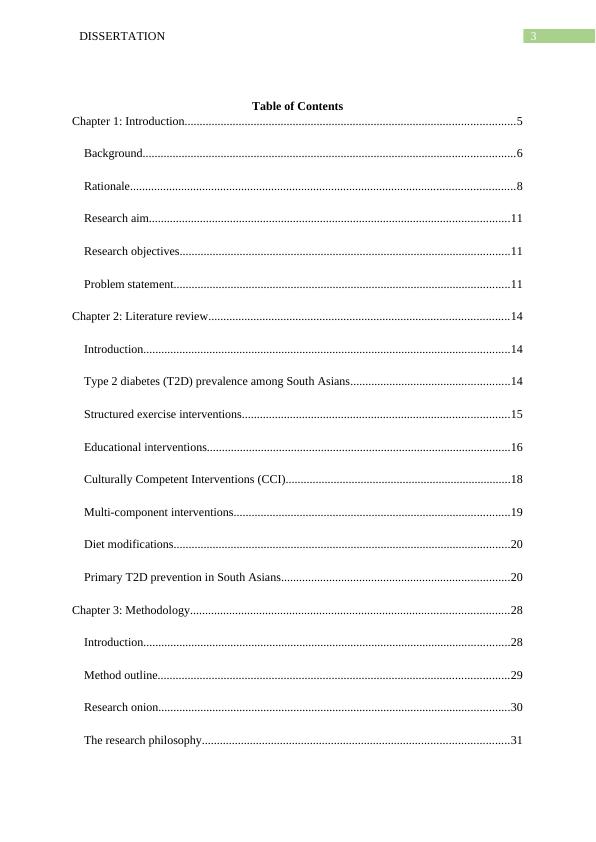
4DISSERTATION
Research approach...............................................................................................................32
Research strategy.................................................................................................................33
Time horizon........................................................................................................................33
Data collection and analysis.................................................................................................34
Research design....................................................................................................................34
Research sampling...............................................................................................................35
Data collection.....................................................................................................................36
Chapter 4: Results and Discussion...........................................................................................38
Results......................................................................................................................................38
Waist circumference.............................................................................................................38
HbA1c levels........................................................................................................................39
BMI/weight..........................................................................................................................41
Awareness in the population and perceived barriers............................................................43
Discussion................................................................................................................................44
Chapter 5: Conclusion..............................................................................................................53
References................................................................................................................................58
Appendix..................................................................................................................................74
Research approach...............................................................................................................32
Research strategy.................................................................................................................33
Time horizon........................................................................................................................33
Data collection and analysis.................................................................................................34
Research design....................................................................................................................34
Research sampling...............................................................................................................35
Data collection.....................................................................................................................36
Chapter 4: Results and Discussion...........................................................................................38
Results......................................................................................................................................38
Waist circumference.............................................................................................................38
HbA1c levels........................................................................................................................39
BMI/weight..........................................................................................................................41
Awareness in the population and perceived barriers............................................................43
Discussion................................................................................................................................44
Chapter 5: Conclusion..............................................................................................................53
References................................................................................................................................58
Appendix..................................................................................................................................74
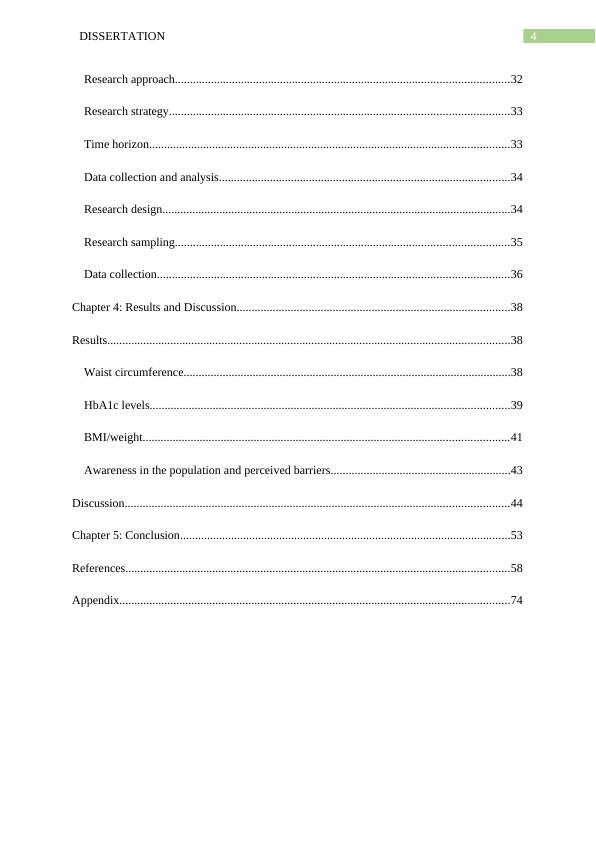
5DISSERTATION
Chapter 1: Introduction
Type 2 diabetes (T2D) or diabetes mellitus refers to a chronic metabolic disorder,
primarily characterised by increase in blood sugar, insulin resistance and deficiency in
secretion of insulin. The condition generally occurs due to insufficient secretion of insulin
hormone from the beta cells of the islets of Langerhans. This insulin resistance refers to
inability of all cells for responding adequately to normal insulin levels, which are primarily
found to occur within the liver, muscles and adipose tissue (Chatterjee et al. 2017). Type 2
diabetes has been identified as a major health concern for people of South Asian descent. The
South Asian population has a 6 times increased likelihood of developing T2D, when
compared to Europeans (Gujral et al. 2013). Recent reports suggest that South Asian
individuals comprise of 4% of the entire UK population. However, they account for an
estimated 8% of all diagnosed cases of diabetes (Ethnicity-facts-figures.service.gov.uk 2018).
People belonging to the South Asian origin commonly refer to the specific individuals with
ethnicity from countries namely, Afghanistan, Bhutan, India, Maldives, Myanmar,
Bangladesh, Nepal, Sri Lanka and Pakistan.
However, most commonly while referring to the South Asian population of the UK,
the people are generally restricted to those of Bangladeshi, Indian and Pakistani descent, who
combine and add to the form the largest ethnic minority of the country. Some of the major
factors that have contributed to the increased susceptibility of the South Asian population to
develop the chronic disease encompass modernisation and urbanisation that result in
sedentary lifestyle, high smoking rates among males, high abdominal fat, and more intake of
refined grains such as, rice that is associated with an elevated risk of diabetes. The research
aims to explore the culture-specific interventions that will either delay the onset or help in
management of T2D among the South Asian population.
Chapter 1: Introduction
Type 2 diabetes (T2D) or diabetes mellitus refers to a chronic metabolic disorder,
primarily characterised by increase in blood sugar, insulin resistance and deficiency in
secretion of insulin. The condition generally occurs due to insufficient secretion of insulin
hormone from the beta cells of the islets of Langerhans. This insulin resistance refers to
inability of all cells for responding adequately to normal insulin levels, which are primarily
found to occur within the liver, muscles and adipose tissue (Chatterjee et al. 2017). Type 2
diabetes has been identified as a major health concern for people of South Asian descent. The
South Asian population has a 6 times increased likelihood of developing T2D, when
compared to Europeans (Gujral et al. 2013). Recent reports suggest that South Asian
individuals comprise of 4% of the entire UK population. However, they account for an
estimated 8% of all diagnosed cases of diabetes (Ethnicity-facts-figures.service.gov.uk 2018).
People belonging to the South Asian origin commonly refer to the specific individuals with
ethnicity from countries namely, Afghanistan, Bhutan, India, Maldives, Myanmar,
Bangladesh, Nepal, Sri Lanka and Pakistan.
However, most commonly while referring to the South Asian population of the UK,
the people are generally restricted to those of Bangladeshi, Indian and Pakistani descent, who
combine and add to the form the largest ethnic minority of the country. Some of the major
factors that have contributed to the increased susceptibility of the South Asian population to
develop the chronic disease encompass modernisation and urbanisation that result in
sedentary lifestyle, high smoking rates among males, high abdominal fat, and more intake of
refined grains such as, rice that is associated with an elevated risk of diabetes. The research
aims to explore the culture-specific interventions that will either delay the onset or help in
management of T2D among the South Asian population.
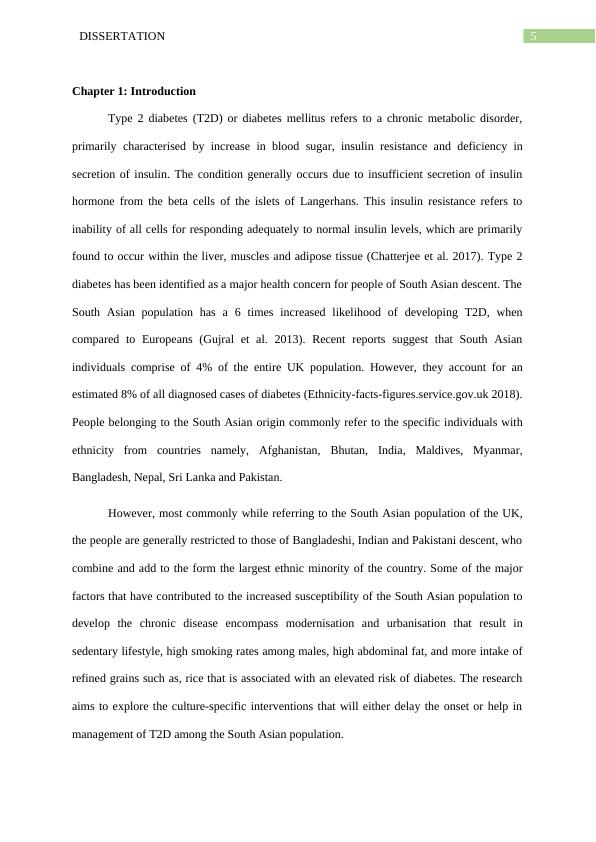
6DISSERTATION
Background
Type 2 diabetes is a progressive health condition where the body attains resistance to the
normalised impacts of insulin hormone and gradually loses the capability to secrete adequate
insulin from the pancreatic cells. This condition gets diagnosed when the body fails to
produce adequate insulin levels or the hormone fails to work effectively to lower the blood
glucose levels. The insulin hormone generally suppresses release of glucose in the liver.
However, in case of T2D, when the body has acquired insulin resistance, the liver fails to
trigger the release of glucose into the bloodstream (Birkenfeld and Shulman 2014).
Proportion of insulin resistance in comparison to the dysfunction of the beta cells of islets of
Langerhans is found to differ among individuals, with some people being primarily insulin
resistant. Such people report minor defects in the secretion of insulin (Tangvarasittichai
2015). On the other hand, others having slight insulin resistance primarily proper insulin
secretion. Some of the potentially important mechanisms that are found to be associated with
insulin resistance and subsequent T2D most often include the following:
An increase in the breakdown of lipid molecules within the adipose or fat cells
Lack of or increased resistance to incretin (Li et al. 2014)
High levels of glucagon in the blood
An increased retention of water and salt by the kidneys
Inappropriate metabolism regulation by the central nervous system.
Incretins are defined as group of metabolic hormones, which play an essential role in
stimulating a reduction in the levels of blood glucose. Incretin hormones are generally
released following consumption of a meal and are imperative for amplifying secretion of
insulin from the pancreatic beta cells, based on a glucose-dependent mechanism (Egan et al.
2014). However, all person with insulin resistance do not develop diabetes. This can be
attributed to the fact that T2D also requires an impairment in the secretion of insulin by the
Background
Type 2 diabetes is a progressive health condition where the body attains resistance to the
normalised impacts of insulin hormone and gradually loses the capability to secrete adequate
insulin from the pancreatic cells. This condition gets diagnosed when the body fails to
produce adequate insulin levels or the hormone fails to work effectively to lower the blood
glucose levels. The insulin hormone generally suppresses release of glucose in the liver.
However, in case of T2D, when the body has acquired insulin resistance, the liver fails to
trigger the release of glucose into the bloodstream (Birkenfeld and Shulman 2014).
Proportion of insulin resistance in comparison to the dysfunction of the beta cells of islets of
Langerhans is found to differ among individuals, with some people being primarily insulin
resistant. Such people report minor defects in the secretion of insulin (Tangvarasittichai
2015). On the other hand, others having slight insulin resistance primarily proper insulin
secretion. Some of the potentially important mechanisms that are found to be associated with
insulin resistance and subsequent T2D most often include the following:
An increase in the breakdown of lipid molecules within the adipose or fat cells
Lack of or increased resistance to incretin (Li et al. 2014)
High levels of glucagon in the blood
An increased retention of water and salt by the kidneys
Inappropriate metabolism regulation by the central nervous system.
Incretins are defined as group of metabolic hormones, which play an essential role in
stimulating a reduction in the levels of blood glucose. Incretin hormones are generally
released following consumption of a meal and are imperative for amplifying secretion of
insulin from the pancreatic beta cells, based on a glucose-dependent mechanism (Egan et al.
2014). However, all person with insulin resistance do not develop diabetes. This can be
attributed to the fact that T2D also requires an impairment in the secretion of insulin by the
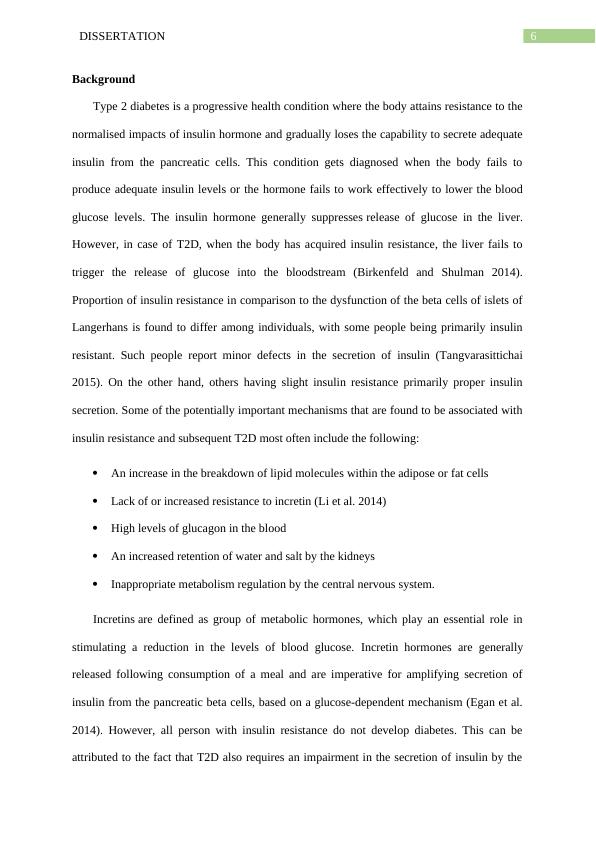
7DISSERTATION
pancreatic beta cells. An estimated 366 million people are found to be currently affected with
T2D, on a global basis (Whiting et al. 2011). This statistical data encompasses people of
almost all developed countries, in addition to those living in the rural and urban regions.
South Asian population are perceived to be at an increased risk for incidence of T2D.
Although the overall prevalence of the health condition among South Asians is considerably
high and ever increasing, there exists heterogeneity among the countries, in terms of the
national prevalence of T2D. This can be attributed to the variations in patterns of lifestyle
factors, socioeconomic development, and existing differences between diagnosed and
undiagnosed cases of T2D in the South Asian countries. Prevalence of T2D has been found
high among the migrant South Asian populations (Tillin et al. 2015).
This has been established by several studies that have identified increased prevalence of
T2D among migrant South Asians, when compared to other ethnic groups. In other words,
increased rates of T2D incidence in South Asians population, across the world is likely
indicative of the major underlying biological factors among South Asians, which in turn are
coupled with several changes in their dietary patterns, activities, and other lifestyle behaviors
(Bajaj et al. 2013). Owing to the contribution of insulin resistance to onset of T2D, South
Asians have been found to display more insulin resistance, when compared to their Caucasian
counterparts, at younger ages and also report low levels of BMI. Some of this elevated
propensity for insulin resistance among the South Asians can be attributed to increase in the
deposition of visceral fat in the target population, when compared to Caucasians (Misra et al.
2008). Although in increase in age is found to elevate the risk for T2D in all populations,
South Asians generally develop the chronic disease at a younger age (Nightingale et al.
2010). One particular study reported that the mean age of T2D diagnosis was found to be the
lowest among South Asians (49 years). This was followed by the Chinese (55 years), the
Blacks (57 years), and the Whites (58 years, who were living in Canada (Chiu et al. 2011).
pancreatic beta cells. An estimated 366 million people are found to be currently affected with
T2D, on a global basis (Whiting et al. 2011). This statistical data encompasses people of
almost all developed countries, in addition to those living in the rural and urban regions.
South Asian population are perceived to be at an increased risk for incidence of T2D.
Although the overall prevalence of the health condition among South Asians is considerably
high and ever increasing, there exists heterogeneity among the countries, in terms of the
national prevalence of T2D. This can be attributed to the variations in patterns of lifestyle
factors, socioeconomic development, and existing differences between diagnosed and
undiagnosed cases of T2D in the South Asian countries. Prevalence of T2D has been found
high among the migrant South Asian populations (Tillin et al. 2015).
This has been established by several studies that have identified increased prevalence of
T2D among migrant South Asians, when compared to other ethnic groups. In other words,
increased rates of T2D incidence in South Asians population, across the world is likely
indicative of the major underlying biological factors among South Asians, which in turn are
coupled with several changes in their dietary patterns, activities, and other lifestyle behaviors
(Bajaj et al. 2013). Owing to the contribution of insulin resistance to onset of T2D, South
Asians have been found to display more insulin resistance, when compared to their Caucasian
counterparts, at younger ages and also report low levels of BMI. Some of this elevated
propensity for insulin resistance among the South Asians can be attributed to increase in the
deposition of visceral fat in the target population, when compared to Caucasians (Misra et al.
2008). Although in increase in age is found to elevate the risk for T2D in all populations,
South Asians generally develop the chronic disease at a younger age (Nightingale et al.
2010). One particular study reported that the mean age of T2D diagnosis was found to be the
lowest among South Asians (49 years). This was followed by the Chinese (55 years), the
Blacks (57 years), and the Whites (58 years, who were living in Canada (Chiu et al. 2011).
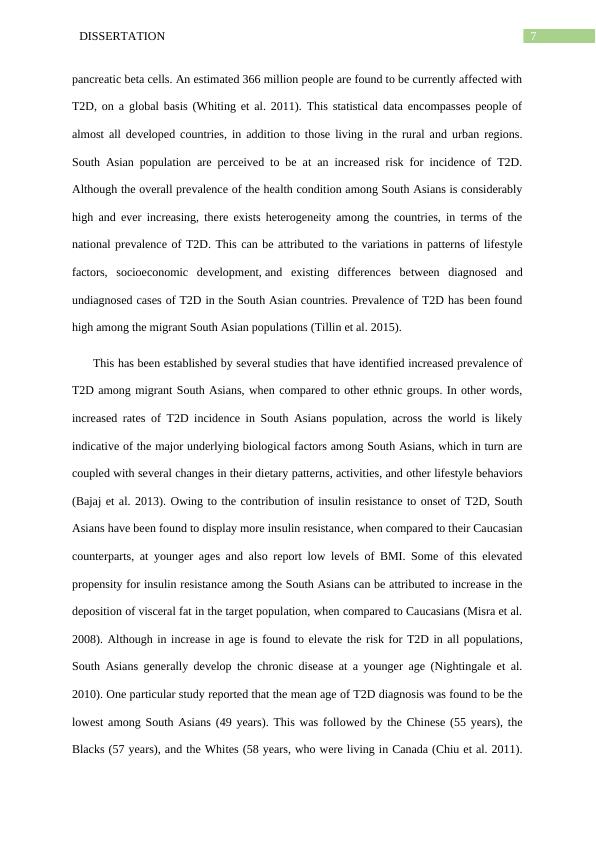
End of preview
Want to access all the pages? Upload your documents or become a member.
Related Documents
Exercise Participation of Diabetes Essaylg...
|28
|9393
|32
The Impacts of type II diabeteslg...
|23
|9138
|453
Effectiveness of Government Legislation and Policies Assignmentlg...
|27
|12531
|37
Impact of Green Supply Chain Management on Organizational Performancelg...
|71
|18259
|463
Cyber Safety Awareness Among School Childrenlg...
|64
|15843
|335
Impact of UK Government Strategies on Childhood Obesitylg...
|40
|12269
|302